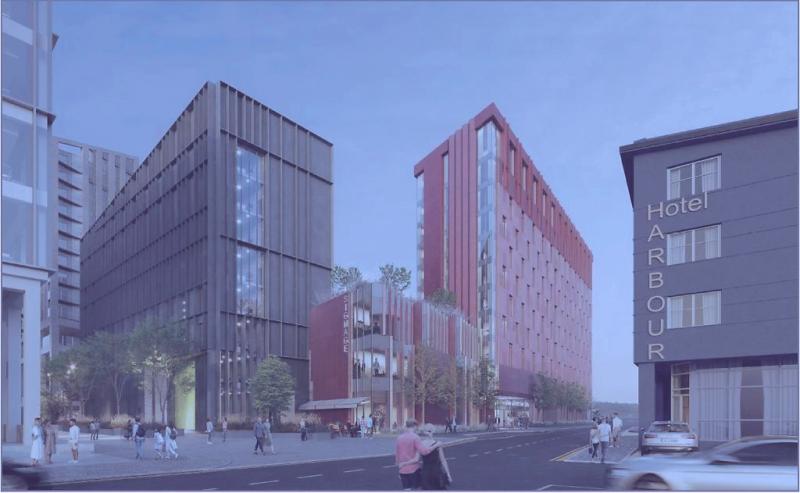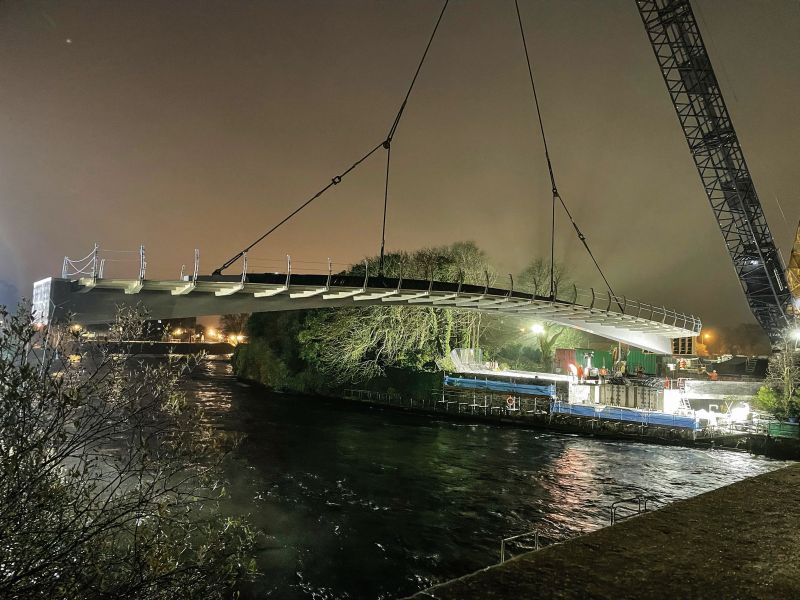CITY TRIBUNE
‘Excessive’ Galway Docks hotel rejected by planners

Galway City Council has turned down scaled-back plans for a 10-storey hotel at Galway Docks, branding it “excessive”.
Last September, Summix BNM Developments lodged a planning application with the Council for a three-storey to eleven-storey hotel (with a rooftop bar and function area) on site of the former Bord na Mona coal yard at the Docks.
The plans also included a restaurant, coffee bar and terraces.
However, the Council sent the company back to the drawing board and told it to revisit the overall scale, height, massing and intensity of the development, but said that the architectural quality of the proposed building is of a good standard.
Planners said there would be a “resultant overbearing expression” onto the Forthill Cemetery and the Long Walk ACA (Architectural Conservation Area). They sought a detailed assessment of the visual impacts on the graveyard.
The Council said that with a height of 38m and length of 70m-90m facing Bóthar na Long and Forthill Cemetery, the building “is not considered to assimilate well; lacks integration with the existing urban form; fails to achieve the visions and aspirations of the Galway City Development Plan . . . detracting from the character and setting of the area”.
The developers came back with scaled-back plans – they reduced the scheme to a maximum of 10 storeys (a height reduction of three metres) and the number of bedrooms reduced from 186 to 174 on the 0.55-acre site.
In its decision to refuse planning permission, the Council said the excessive density, scale and height on a very constrained site would represent overdevelopment of the site and would have a detrimental impact on the character and setting of Forthill Cemetery.
“The development does not adhere to the principles of good urban design set out in the Galway City Development Plan and in this regard, it is considered to lack the capacity for integration with the existing urban form, contribute positively to street enclosure and fails to sympathetically assimilate with Galway’s townscape,” the decision reads.
A submission from the Harbour Hotel – located opposite the site – welcomed the redevelopment of the vacant site but said the build and massing of the building would create “a visually dominant feature on this prominent corner location which will have an overbearing impact on the street scene and Forthill Cemetery”.
It added that the height would have a detrimental impact on the existing built and natural heritage of the area.
The submission also noted there were no carparking spaces provided in the plans, and there is a shortage of spaces in the city centre.
The Harbour Hotel submission claimed that the additional bedrooms would result in an overconcentration of tourism accommodation and an “excessively transient” population in the vicinity of the site.
City Council Heritage Officer, Dr Jim Higgins, said in his view the site should not be developed as the possibility of fort-related archaeology being present there is high.
He said that in the 1960s, a well was found on the CIE side of the site, close to the boundary wall.
According to the planning application, demand for hotel rooms in Galway will exceed “pre-Covid” levels by 2023.
“Provision of hotel accommodation at this location will enhance overall visitor experience on offer in the city, with convenient access to a broad range of attractions, as well as present a major new opportunity to capture a proportion of the spend generated by visitors to the area in a part of Galway City that has been in decline for many years,” the application reads.
Summix – which is headed by British technology entrepreneurs Shukri Shammas and Tareq Naqib – has already partnered with Galway developer Gerry Barrett on the approved plans for 360 student bed spaces on a site at Queen Street, behind Bonham Quay.
They have also partnered on the recently-approved €320m regeneration proposal at Ceannt Station called ‘Augustine Hill’, which includes homes, a new shopping precinct with four public squares, a multiplex cinema and eleven streets linking the city centre with the Docks and Lough Atalia.
Image: An architect’s impression of the hotel (with red facade) alongside the Bonham Quay development
CITY TRIBUNE
Galway ‘masterplan’ needed to tackle housing and transport crises

From the Galway City Tribune – An impassioned plea for a ‘masterplan’ that would guide Galway City into the future has been made in the Dáil. Galway West TD Catherine Connolly stated this week that there needed to be an all-inclusive approach with “vision and leadership” in order to build a sustainable city.
Deputy Connolly spoke at length at the crisis surrounding traffic and housing in Galway city and said that not all of the blame could be laid at the door of the local authority.
She said that her preference would be the provision of light rail as the main form of public transport, but that this would have to be driven by the government.
“I sat on the local council for 17 years and despaired at all of the solutions going down one road, metaphorically and literally. In 2005 we put Park & Ride into the development plan, but that has not been rolled out. A 2016 transport strategy was outdated at the time and still has not been updated.
“Due to the housing crisis in the city, a task force was set up in 2019. Not a single report or analysis has been published on the cause of the crisis,” added Deputy Connolly.
She then referred to a report from the Land Development Agency (LDA) that identified lands suitable for the provision of housing. But she said that two-thirds of these had significant problems and a large portion was in Merlin Park University Hospital which, she said, would never have housing built on it.
In response, Minister Simon Harris spoke of the continuing job investment in the city and also in higher education, which is his portfolio.
But turning his attention to traffic congestion, he accepted that there were “real issues” when it came to transport, mobility and accessibility around Galway.
“We share the view that we need a Park & Ride facility and I understand there are also Bus Connects plans.
“I also suggest that the City Council reflect on her comments. I am proud to be in a Government that is providing unparalleled levels of investment to local authorities and unparalleled opportunities for local authorities to draw down,” he said.
Then Minister Harris referred to the controversial Galway City Outer Ring Road which he said was “struck down by An Bord Pleanála”, despite a lot of energy having been put into that project.
However, Deputy Connolly picked up on this and pointed out that An Bord Pleanála did not say ‘No’ to the ring road.
“The High Court said ‘No’ to the ring road because An Bord Pleanála acknowledged it failed utterly to consider climate change and our climate change obligations.
“That tells us something about An Bord Pleanála and the management that submitted such a plan.”
In the end, Minister Harris agreed that there needed to be a masterplan for Galway City.
“I suggest it is for the local authority to come up with a vision and then work with the Government to try to fund and implement that.”
CITY TRIBUNE
Official opening of Galway’s new pedestrian and cycle bridge

The new Salmon Weir pedestrian and cycle bridge will be officially opened to the public next Friday, May 26.
Work on the €10 million bridge got underway in April 2022, before the main structure was hoisted into place in early December.
A lunchtime tape-cutting ceremony will take place on Friday, as the first pedestrians and cyclists traverse the as-yet-unnamed bridge.
The Chief Executive of Galway City Council, Brendan McGrath, previously said the bridge, once opened, would remove existing conflicts between pedestrians, cyclists and traffic “as well as facilitating the Cross-City Link public transport corridor over the existing 200-year-old bridge”.
The naming of the new bridge has been under discussion by the Council’s Civic Commemorations Committee since late last year.
One name that has been in the mix for some time is that of the first woman in Europe to graduate with an engineering degree – Alice Perry.
Ms Perry, who was from Wellpark, graduated from Queen’s College Galway (now University of Galway) in 1906. The university’s engineering building is named in her honour.
The bridge was built by Jons Civil Engineering firm in County Meath and was assembled off-site before being transported to Galway. Funding for the project was provided in full by the National Transport Authority and the European Regional Development Fund.
(Photo: Sheila Gallagher captured the city’s new pedestrian footbridge being raised on the south side of the Salmon Weir Bridge in December. It will officially open next Friday, May 26).
CITY TRIBUNE
Minister branded ‘a disgrace’ for reversing land rezoning in Galway City

From the Galway City Tribune – Minister of State for Local Government and Planning, Kieran O’Donnell was labelled a “disgrace” for overturning councillors’ decisions to rezone land in the new City Development Plan.
Minister O’Donnell (pictured) confirmed in a letter to Council Chief Executive Brendan McGrath last week that he was reversing 25 material alternations made by councillors to the CDP 2023-29. He made the decision on the advice of Office of Planning Regulator (OPR).
Minister O’Donnell directed that 14 land parcels that were subject to land-use zoning changes by councillors as part of the Material Alterations to the Draft CDP should be reversed.
He directed that a further 11 land parcels in the city should become “unzoned”.
The Minister found that the CDP had not been made in a manner consistent with recommendations of the OPR, which required specific changes to the plan to ensure consistency with the national planning laws and guidelines.
At last week’s Council meeting Cllr Eddie Hoare (FG) asked for clarity on the process by which councillors could rezone the lands that had been changed by the Minister’s direction.
Cllr Declan McDonnell said, “What he [Minister O’Donnell] has done is an absolute disgrace”.
And he asked: “Do we have to have another development plan meeting to deal with it?”
Both Cllrs Hoare and McDonnell wondered what would become of the lands that were rezoned or unzoned by the ministerial direction.
Mr McGrath said the Council had put forward an argument in favour of retaining the material alterations in the plan, but ultimately the Minister sided with OPR.
He said if councillors want to make alterations to the new plan, they could go through the process of making a material alteration but this was lengthy.
The Save Roscam Peninsula campaign welcomed the Minister’s decision.
In a statement to the Galway City Tribune, it said the direction would mean the Roscam village area on the Roscam Peninsula will be unzoned and a number of land parcels would revert back to agriculture/high amenity.
A spokesperson for the campaign said: “the material alterations made by city councillors following lobbying by developers continued the long-standing practice of councillors facilitating a developer-led plan rather than an evidence- and policy-based plan that meets the needs of the city.
“The Minister’s direction is an important step in restoring confidence in the planning system. It is clear from the City Council’s own evidence on future housing projections that there was no requirement to zone these lands for residential purposes in order to meet the needs of the targeted population increase up to 2029,” the spokesperson added.















